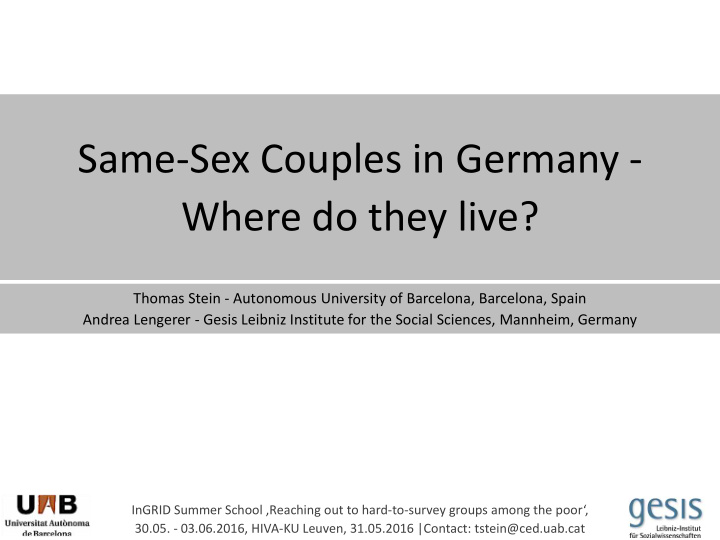



Same-Sex Couples in Germany - Where do they live? Thomas Stein - Autonomous University of Barcelona, Barcelona, Spain Andrea Lengerer - Gesis Leibniz Institute for the Social Sciences, Mannheim, Germany InGRID Summer School ‚Reaching out to hard-to-survey groups among the poor‘, 30.05. - 03.06.2016, HIVA-KU Leuven, 31.05.2016 |Contact: tstein@ced.uab.cat
Leaving Point • Detailed spatial segregation research on same-sex couples (ssc) for Germany almost non-existent • Aiming to figure out about spatial distribution, also over time • Questions to answer (among others): – Which areas (Federal States) are popular, which are not? – Are there differences between male and female ssc? – Do differences in regional distribution over time exist? – Which characteristics of a spatial unit determine the decision of a ssc to live there? InGRID Summer School KU Leuven 2 Thomas Stein | 31.05.2016
Data • Scientific Use Files (70%) of German Micro Censuses (1% of German population) 1996 - 2011, Age 16+ • Unit of analyzes: individuals living in a same-sex couple (ssc) • Household principle only couples living together (at main residence) • Detection ssc indirectly InGRID Summer School KU Leuven 3 Thomas Stein | 31.05.2016
Results • Absolute counts from 1996 to 2011 entire Germany: Individuals living in a Same-Sex Couple 500 450 400 350 300 n 250 200 150 1996 1997 1998 1999 2000 2001 2002 2003 2004 2005 2006 2007 2008 2009 2010 2011 Year gays lesbians InGRID Summer School KU Leuven 4 Thomas Stein | 31.05.2016
Results • Dissimilarity Index Spatial distribution between Same-Sex & Opposite-Sex Couples (osc) 0,40 0,36 Dissimilarity Index 0,32 0,28 0,24 0,20 0,16 0,12 1996 1997 1998 1999 2000 2001 2002 2003 2004 2005 2006 2007 2008 2009 2010 2011 Year gays lesbians InGRID Summer School KU Leuven 5 Thomas Stein | 31.05.2016
Results • Mapping (example: moving average 2006 (2004-2008)) Number ssc on 1,000 osc 0 - < 0.5 0.5 - < 1.0 1.0 - < 1.5 1.5 - < 2.0 2.0 - < 4.0 4.0 + Females Males InGRID Summer School KU Leuven 6 Thomas Stein | 31.05.2016
Issues • Data are generally scarce, fluctuation of quantity of ssc within a geographical unit between consecutive years • Ssc are underestimated, e.g., due to Item-Nonresponse (Lengerer & Stein, 2016, DGD-conference Leipzig, Germany) • Geographical data in Micro Censuses are scarce, only detail up to Federal State level (n=16) • Even though with more geographical detail (from Statistical State Offices, NUTS-2) analyzes difficult as many regional units won‘t have many/ any cases • How to deal with lack of data? How to improve/ adjust? InGRID Summer School KU Leuven 7 Thomas Stein | 31.05.2016
Thank you. InGRID Summer School KU Leuven Thomas Stein | 31.05.2016
Recommend
More recommend